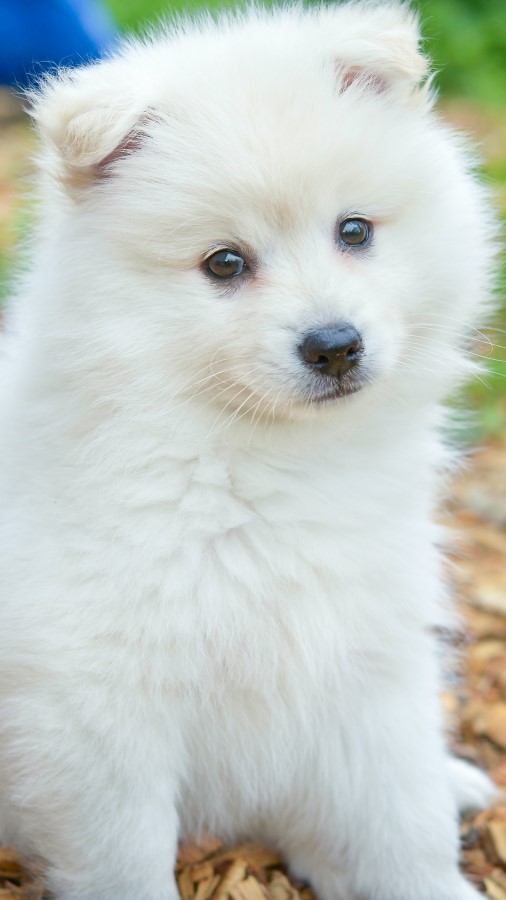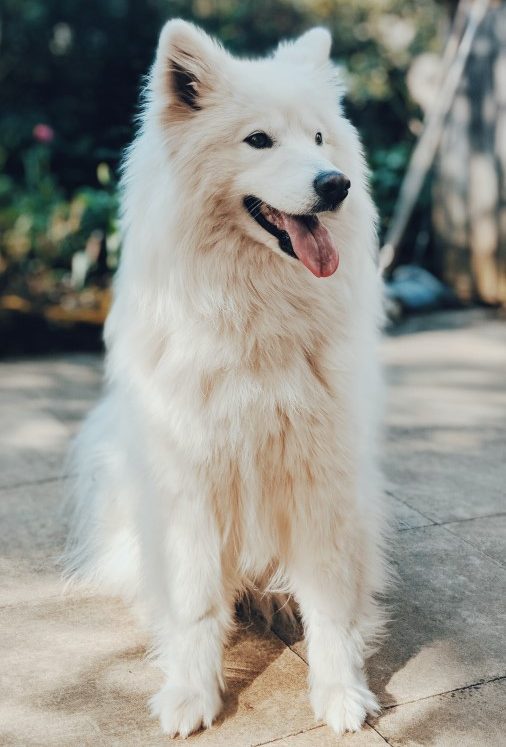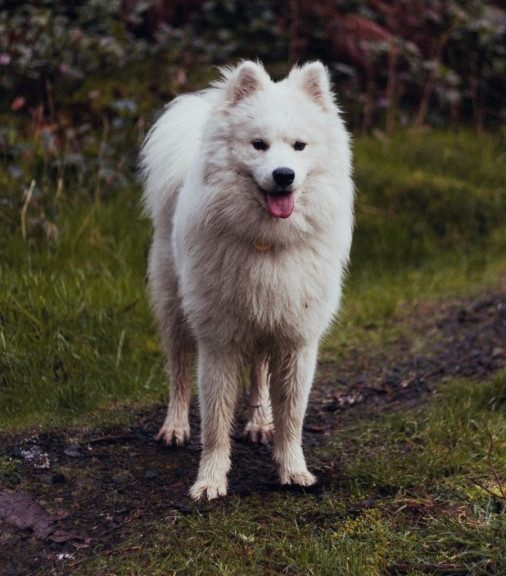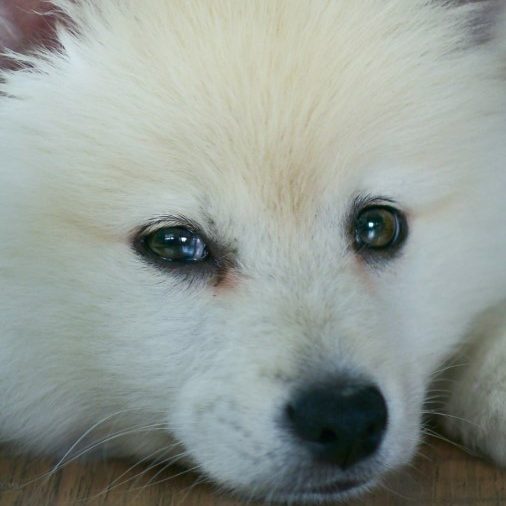Samoyed Dog Breed Guide
Topics Covered:

 Greencross Vets
Greencross Vets
Topics Covered:
Pronounced Sa-muh-yed, the Samoyed (A.K.A. Sammie) emerged at the end of the 19th century in northwest Siberia, and was primarily bred as a sled dog. Aptly named after the nomadic Samoyede people, they were raised to haul sledges on expeditions around the Artic Circle, with only the fittest and strongest dogs surviving these challenging explorations. Samoyeds were also used to hunt and herd reindeer.
Due to this, no ‘toy’ breeds of this dog ever arose in earlier times as they would not have survived the harsh arctic expeditions or labour as a sled dog. However, miniature Samoyeds, also known as teacup Samoyeds, were introduced later by the Norwegian explorer Fridtjof Nansen. He used these small sized Samoyeds on his explorations; however, they were not as sturdy and therefore are not as widespread today.
The Samoyed signature smiles also arose out of necessity, as the upturned corners of its mouth prevented drool from freezing into ice on their face in these challenging ventures.
Interestingly the Samoyede people loved this breed and were known to even include their dogs in family activities and allow their Samoyeds to sleep beside them in their huts for warmth. This is believed to have formed the need for companionship, loyalty, and trust Samoyeds have to this day.
Samoyeds are a basal breed that descended from the Spitz group and the Soviet Nenet herding Laika, a dog that had a range of coloured coats. However, over time this was phased out and the trademark Samoyed shiny white coat remained.
The breed arrived in England in the late 1800’s often as gifts from Russia’s Cszar. Queen Alexandria was very fond of the breed and many English and American Samoyeds today descended from her kennels. The standard for Samoyeds was adopted and finalised in 1909 in England.

Samoyeds are good-natured, gentle, and friendly, in alignment with the breed’s signature upturned smile. The breed enjoys spending their day around their family, as they thrive off companionship and their owner’s love and attention. Samoyeds love to feel a part of the family unit.
A Samoyed sent to the backyard alone for days on end is torture to this very social breed and can result in noticeable personality changes. These can include excessive digging up of the yard and destroying furniture.
Samoyeds also remain playful into old age, always loving to interact with their family and socialise with other dogs. The breed loves a backyard where it has the space to roam free and play. However, they are known to wander off, so ensure their space is safely enclosed.
Samoyeds are also very intelligent and strong-willed, stemming from their past as a sledge dog. As a result of this, training can sometimes be challenging as Samoyeds often get bored with repetition. Therefore, agility training is a great option for this breed to keep them engaged.
Samoyeds are also known to quickly learn how to ‘shake hands’ and can be a bit mischievous, rapidly learning to open doors. This breed is also talkative and stubborn, known to voice their likes and dislikes in high-pitched barks, bellows, or growls.

The Samoyed is a medium-sized dog breed with an average height of 50cm-60cm that differs between males and females. As a puppy, Samoyeds six months and older typically weigh between 12kg to 21kg and should be finished growing to their full size by 16 months.
Once your Samoyed puppy becomes an adult, males often weigh between 20-30kg and reach an average height of 53cm-60cm. Females on the other hand weigh between 16kg-20kg and grow to be as tall as 48cm-53cm.
Like any other dog breed, Samoyeds do have some genetic health conditions you should be aware of before considering owning this dog breed:
As Samoyeds are very active dogs, bred to haul sledges through snow, they need at least 2 hours of exercise per day. This could include long walks, playing in the backyard, or training.
They also require some mental and physical stimulation to avoid boredom. A bored Samoyed can quickly turn into an escape artist, digging holes and finding weaknesses in your fence. As long as your Samoyed has been exercised, they can really have a yard of any size. However, as a medium-sized dog breed born to roam, Samoyeds do not suit long-term apartment or indoor living and should have some space outside to wander around and play.
Samoyeds were originally bred to become part of the family unit, even sleeping with their owners in their tents. Because of this natural attachment to humans, Samoyeds long for companionship, attention, and affection from their owners – more than other dog breeds. You should never leave your Samoyed alone for more than four hours and an extreme maximum of eight hours. If left alone for prolonged periods of time Samoyeds are known to bark loudly and engage in destructive behaviours.

Samoyeds should be fed with a complete and balanced diet. As their breed is prone to obesity, it is vital, as an adult, that their calorie intake equates to calories burnt during exercise.
As any medium-sized puppy, Samoyed puppies should be fed a premium quality medium puppy food to ensure correct growth. Once they mature, around 12-16 months, they can be transitioned to an adult food. It is really important to make sure that during this transition period they do not become overweight.
It is always recommended that you make an appointment with a vet to discuss an appropriate well-balanced diet for your pet. You can also use the Petbarn Food Finder to help find the best nutrition choice for your pet.

Samoyeds are known for their trademark smile and glistening fluffy white coat. Their coat can come in a pure white, white, cream, or biscuit colour with no distinguished markings or patterns.
Interestingly, this coat is double layered with a dense undercoat and a top straight coat. This functions to keep them protected from the elements, acting as insulation to keep warm in cooler climates and cool during the summer. Additionally, the outer layer or ‘guard hairs’ has longer hairs which enable cool air to circle close to the dog’s skin after their undercoat is shed while the thick, dense undercoat consists of short hairs and has a woolly texture. Due to this double coat, Samoyeds thrive in cooler weather as warm climates can result in overheating.
Samoyeds shed considerably throughout the year due to their thick double coat, but particularly in spring and autumn lasting about two to three weeks. As a result, Samoyeds grooming routine is regular, and they must be brushed daily when the coat is shedding or up to twice a week when it is not, to keep their thick and fluffy coat detangled and healthy.
Samoyeds should also be bathed frequently and as often as a weekly basis, but no longer than every 6 weeks due to their double coating.
Shaving your Samoyed is controversial as with other double coated arctic breeds, as the thick coat takes a long time to grow back, and may never grow back the same. However, you can trim your Samoyed to get rid of any matting and overgrown hair which may be falling into their eyes or face.
Samoyeds are playful, friendly, social, and amazing with both other pets and children. Due to their playful nature, they provide a great companion for a young child or children. As always, any play needs to be supervised
Similarly, as they are a friendly breed Samoyeds interact well with other dogs. Not only those already part of the family, but also pets they meet in the dog park or on walks. However, as they are herd dogs, they sometimes have a tendency to chase or nip.
If you’re looking for how to best introduce your Samoyed to your family or other pets, read this informative article from Greencross Vets here.
Samoyed dogs can get as big as 50cm-60cm in height and from 16kg to 30kg in weight. Male Samoyeds are typically larger and can range from 20-30kg and 53-60cm. While female Samoyeds weigh between 16kg-20kg and grow to be as tall as 48cm-53cm.
Samoyeds are active dogs and as such need at least 2 hours of exercise daily with a complete and balanced diet. They also require regular grooming due to their double coat and shedding. However, they are one of the most loving breeds and form close bonds with their owners, often becoming an integral part of the family unit.
Samoyeds are known for their loving, friendly and sociable nature. They thrive off spending quality time with their owner and companionship, always wanting your undivided love and attention. The breed is also highly intelligent and quick to pick up training and tricks – they love to be mentally stimulated and play outside!
Samoyeds are medium-sized dogs that were originally bred for herding reindeer in Serbia and have a thick double-layered coat. They are known for their sociable, friendly, and lovable nature.
Samoyeds are known to be talkative, voicing their likes and dislikes in a bark, growl, or bellow. A great tip to reduce their barking is to ignore their cries, or sternly tell them off with a ‘no’. Alternatively, place them in their crate, bed or outside until they stop barking. If they do obey your commands, they should be rewarded to reinforce this positive behaviour.
Alternatively, training with the experts at Greencross Vets is also a great option to get personalised tips, techniques, and solutions to your situation.
The lifespan of a Samoyed is on average 12 to 14 years.
Samoyeds shed a lot throughout the year due to their thick double coat. During shedding season, they should be groomed twice a week by brushing their fur to remove hair, knots, tangles, and matted sections from their coat. Outside of this Samoyeds should be brushed daily to keep their coat in pristine condition.
At Greencross Vets, nothing is more important than the health and wellbeing of your four-legged friend. If you have any more questions, please reach out to your local Greencross Vets. You can find your local Greencross Vets here. We are more than happy to help!
Or if you’re looking to adopt, find your new best friend with Petbarn adoptions.